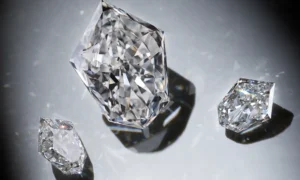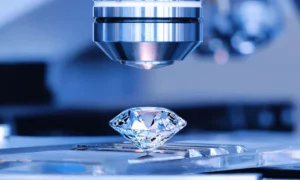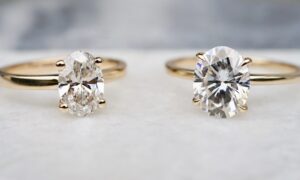The popularity of lab grown diamonds is rising for a variety of reasons. This includes their beauty, high quality, and most importantly its affordability. It goes without saying that the debate between diamonds that are mined and diamonds that are made in a lab is changing.
As much as three billion years ago, under conditions of intense pressure and heat, natural diamonds originated deep inside the planet. Diamonds created in a laboratory are much more recent. Although lab created diamonds are stunning, some people may choose not to purchase them because they feel mined diamonds are superior.
Since their entry into the global diamond jewellery market, lab grown diamonds, also known as cultured diamonds, have sparked debate and given consumers the option to pick between a conventional earth-mined diamond or a conflict-free diamond that has been manufactured in a lab.
If you are one of those people wondering about lab grown diamonds, and why they are causing such a spark in the market, we have put together a few things that you need to know about them.
They take less time to create compared to natural diamonds
Lab grown diamonds take only a few weeks to produce rather than forming thousands of years beneath. Diamonds taken from the earth and those manufactured in a lab share the same carbon structures. Just that the procedure is accelerated in a controlled lab setting.
A carbon seed is used as the initial step in this procedure, and it is then put into a chamber with heat, pressure, and gasses to cause the diamond to develop. This entire process takes six to ten weeks.
After complete crystallization, the diamonds are polished and cut. This means that selecting your ideal diamond for a lifetime is simple; just decide on the type of diamond you want, and it will appear right before your eyes. You can get them in whatever diamond cuts, diamond shapes or diamond styles you want.
Lab grown diamonds are as real as natural diamonds
Diamonds made in laboratories are not imitations, rather, they are completely identical to diamonds taken from the earth.
Between a lab-created diamond and one that was mined from the soil, there is no discernible difference. In fact, even many jewelers using loupes can’t see it! Lab grown diamonds are similar to earth-mined diamonds in terms of chemistry, physics, and optics.
So, your lab grown diamond engagement ring will look and feel the same as that of a naturally-mined one.
They have the same crystal structure and lovely shine as “genuine diamonds,” with the added benefit of being a little less expensive.
Lab Grown Diamonds are also subject to natural color tints and flaws
Since lab grown diamonds are created from the same chemical elements as diamonds that are extracted from the soil, they are subject to the same natural colorations and imperfections.
Due to their similar authenticity to naturally occurring diamonds, which are formed and colored in accordance with the structure of the rock, lab grown diamonds are also more beautiful.
They are nevertheless desirable to today’s environmentally conscious customer despite this.
Sustainable Resources
Since a lab grown diamond and an earth-mined diamond have the exact same chemical makeup, they are indestructible.
Lab grown diamonds are identical to earth-mined diamonds in shape aside from origin. This is why more customers have started to choose them as a sustainable alternative for their engagement rings, proposal rings or wedding bands.
No matter how or where it is produced, whether it comes from the ground or is produced artificially in a lab, a diamond is still a diamond. Additionally, because lab grown diamonds are composed of the same substance as natural diamonds, they share similar chemical and visual characteristics.
Graded the same way as naturally formed diamonds
Lab created diamonds are graded according to the 4Cs (cut, clarity, color, and carat) just like their earth-mined counterparts to demonstrate their authenticity and purity.
Therefore, you can learn the diamond grade that was used for that specific stone when you purchase your lab grown diamond engagement ring.
A diamond grader will evaluate the size, clarity, and flawlessness of the diamond as well as how well it has been cut into the jewel. As a result, each lab-created diamond is accompanied with a certificate from a recognized laboratory.
They are created under the CVD and HPHT processes
You must be aware that the original mined diamonds are created beneath the Earth’s crust under conditions of great pressure and temperature. Today’s mined diamonds were produced billions of years ago.
Now, lab grown diamonds are produced using the Chemical Vapor Deposition (CVD) or High Pressure High Temperature (HPHT) processes, just to sustain the process and ensure that the lab grown diamonds have all the characteristics of naturally mined diamonds.
However, as compared to the HPHT technique, the CVD procedure is highly regarded.
High quality
When we discuss lab grown diamond, we mean that it is exceptional in terms of both quality and style. Compared to the dirt diamond, which is extracted from the earth using dynamite and diesel, it is one of the finest diamonds.
This diamond is suitable for making jewels because of its brighter, whiter, and more pure and straightforward form. This product is special due to its highest purity grade, which is used to pinpoint its most elite and pure form.
Environmentally Friendly
It is generally known that the extraction of diamonds from the earth uses a lot of resources and has an adverse effect on the environment due to air pollution.
Large-scale mining operations, particularly those that employ open-pit mining methods, can significantly destroy forested areas. The largest factor is the destruction of forests and the building of communities and highways due to mining.
Additionally, once a diamond mine has been fully developed, the materials and minerals that have been taken out are not always replenished, leaving you with an ecosystem that is unable to renew. This may result in water pollution, unusable land for farming or other purposes, and land that is vulnerable to severe erosive processes and flooding
As an alternative to earth-mined diamonds, lab-created diamonds are produced in controlled laboratories and are therefore more environmentally friendly.
Less expensive
Lab grown diamonds are less expensive than those that are mined. The explanation is simply straightforward. Compared to mined diamonds, the supply chain for lab grown diamonds is more effective and profitable.
Your lab grown diamond engagement ring will contain a genuine, flawless diamond that was only created in a lab. It doesn’t need a huge industry to be propped and mined from scratch. As a result, it is simply offered as what it is—a genuine diamond that can be up to 40% less expensive than natural diamonds.
Therefore, if you’re on a tight budget, it’s advisable to choose the lab grown diamonds. You could get diamond tennis bracelets, diamond stud earrings and even a wedding set without breaking the bank.
Assurance of Origin
The origin of the diamonds is the only distinction between natural diamonds and lab-certified diamonds.
As you are all aware, the latter is made in a laboratory, as opposed to natural diamonds, which are formed naturally beneath the Earth’s crust.
Since you are aware of the location of these gems’ birth, you can be certain of their origin.
Conclusion
Choose a lab grown diamond that is within your price range, and deal with the best diamond possible. A priceless diamond with a distinctive look and feel will never contradict your ideas and will always produce an improved outcome.
Choose the best option for the future because it will be a valuable asset. Diamonds have a genuine beauty that has no precedent in human history. You will always be amazed by the shape and feel of lab grown diamonds in person. Go for a lab grown diamond to see the difference for yourself.



































